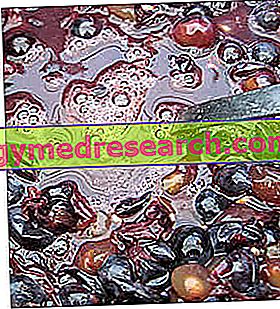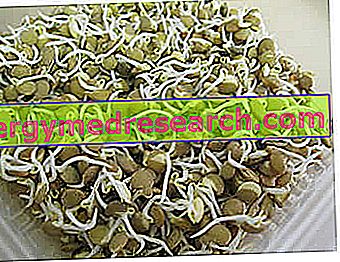Generality
In its common sense, the term "must" identifies the liquid obtained from the pressing of the grapes (grains) of grapes .

- cooked must is necessary for coloring some particular wines;
- the siphon is necessary for raising the final alcohol content (see the article: Marsala);
- the concentrated must is produced industrially and has a high sugar content (up to 50-70%); it is useful for the correction of little sweet musts.
- the sweet filtered must is deprived of nitrogenous substances and is therefore LOCKED by fermentation; it is used to make cuts and refermentations.
- in the silent must fermentation is blocked through the massive addition of sulfur dioxide; this must be removed from the product before use.
Other musts, different from the fresh and from the ones just described, are: the partially fermented must (having an alcohol content between 1 and 60% of the potential) and the concentrated - rectified must (more similar to grape sugar than to normal concentrate).
The must, depending on the type of grape or grape variety and the wine-making technique, can give rise to white, black or rosé wines. Only afterwards, depending on the timing and the bottling technique, can the beverage acquire firmness or effervescence.
Grape must is not to be confused with grape juice
Composition of the Must
The must has a watery consistency but also contains a solid portion. The liquids, of course, derive from the water-soluble portion of the berries, while the solids are composed of more or less important portions of wood (petioles and, sometimes, stalks / stalks), skins and seeds.
From the chemical point of view (considering the appropriate differences between grapes and grapes), the must contains 70-80% of water, while the remaining 20-30% is represented by: simple sugars, acids, mineral salts, nitrogenous substances (inorganic and protein), phenolic substances (pigments and tannins), pectic substances (pectins and related hydrolytic residues), vitamins, crushing residues and, no less important, yeasts (responsible for wine fermentation). In the table below, taken from the text " How to Make Wine " by Lucio Bussi, we find summarized the main components of the must ordered by QUANTITATIVE importance.
| Average composition of the must | ||
| COMPOUNDS | CONTENT | |
| (G / L) | % or ‰ | |
| water | 700-800 | 70-80% |
| Sugars | 150-250 | 15-25% |
| acids | 7-14 | 7-14 ‰ |
| Mineral salts (potassium, calcium, magnesium, sodium etc.) | 1-3 | 1-3 ‰ |
| NITROBE SUBSTANCES (inorganic, proteins and amino acids) | 0.2-1.5 | 0.2-1.5 ‰ |
Functions of the various components of the must
Water is the main element of the must and, since it is an essentially water-soluble solution (except for crushing residues and a few other elements), its function is mainly that of solvent; from the enological point of view, the quantity of water mainly affects the relationship with sugars, therefore on the definitive alcoholic strength.
Simple carbohydrates are mainly made of fructose. This, which in the right microbial transformation is converted into ethyl alcohol, must not be too scarce, but not too abundant either. In both cases (and in compliance with the specification), the must must be corrected before fermentation to reach the right sugar level.
mineral salts (potassium and calcium, which act as alkaline bases), can crystallize to form salts such as cremortartaro (or potassium acid tartrate) and calcium tartrate; these, being slightly soluble, precipitate and deposit, while other salts such as malic acid and neutral tartrate dissolve more easily.
The phenolic dyes and tannins (polyphenols) are present in proportion to the quantity of marc and their maceration time in the must (the pomace is the solid part composed of skins, seeds and other wood components). More precisely, the pigments are more present in the skins, while the tannins abound in the seeds and stalks / stalks. The pigments of the must determine the color of the product, while the tannins constitute the body of the finished wine (tannic or astringent action).
More than from the technical or oenological one, vitamins take on a more relevant role from a nutritional point of view. Among these, especially C, some provitamins A and some of the B group stand out. As regards minerals (ions and salts), they are more concentrated: potassium, calcium, magnesium, sodium, phosphates, sulphates, chlorides, iron and copper. The latter, in addition to enriching the nutritional profile of the must, regulate fermentation and influence the flavor and clarity of the wine.
The nitrogenous substances are responsible for the development of yeasts useful for fermentation, during which they are converted into aromatic substances (higher alcohols) necessary for the structuring of the final aroma. On the other hand, an excess of nitrogenous substances in the must can determine the instability and the turbidity of the finished product.
Il Mosto ... Do you eat?
As has been pointed out, must is an intermediate product of wine.
However, a fresh, filtered and pasteurized must, obviously for nothing or little fermented, can be used for the production of a particularly pleasant sweet food.
Some people also consume liquid, fresh and raw, but all this goes at the risk and danger "gastro-intestinal" of those who take it! It is in fact a drink that is potentially rich in yeasts which, if taken in large quantities, can give rise to symptoms such as: swelling, abdominal tension, flatulence and diarrhea.
As far as dessert is concerned, it is the well-known "grape pudding" or "grape juice". This food essentially contains carbohydrates, it is almost completely devoid of proteins, lipids and fibers and has a variable caloric content depending on the grapes and the added sugar; in this regard, in principle, also taking into consideration the flour added as a binder, the caloric intake of the sauces should not be detached too much from 100kcal / 100g.
For more details, see Alice's video recipe: Grain Pudding - Sugoli con Mosto di Grape.
Grape pudding - Sugoli with grape must
X Problems with video playback? Reload from YouTube Go to Video Page Go to Video Recipes Section Watch the video on youtubeBibliography:
- How to make wine - Lucio Bussi - Demetra - pag. 40:42.



